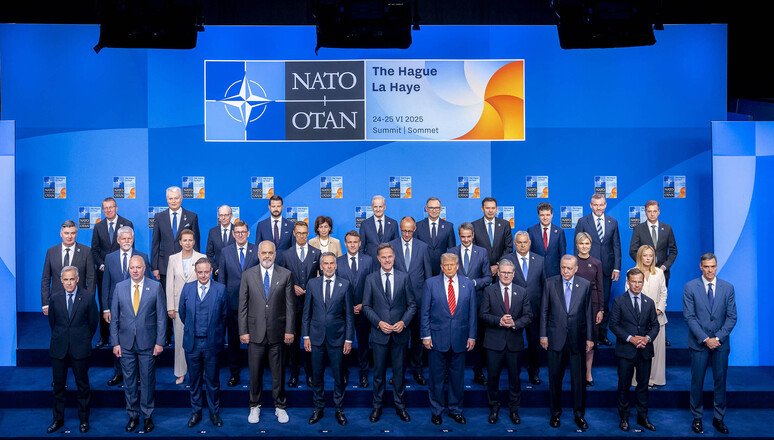The North Atlantic Treaty Organization’s Hallucinations
NATO, 7 Jul 2025
Vijay Prashad | Peoples Dispatch – TRANSCEND Media Service
Having agreed to increase their military spending to 5% of their Gross Domestic Product (GDP), the European states have created a series of problems for themselves.
30 Jun 2025 – By the end of the annual meeting of the North Atlantic Treaty Organization (NATO) in The Hague in June 2025, it became clear that everything was about money. In fact, the final communiqué was perhaps the shortest of any NATO meeting – only five points, two about money and one to thank the Netherlands for hosting the summit. The Hague Declaration was only 427 words, whereas in the previous year, the Washington Declaration was 5,400 words and ran to 44 paragraphs. This time, there was not the granular detail about this or that threat, nor the long and detailed assessments of the war in Ukraine and how NATO supports that war without limit (“Ukraine’s future is in NATO”, the alliance said in 2024, a position no longer repeated in the brief statement of 2025). It was clear that the United States simply did not want to permit a laundry list of NATO’s obsessions. It was instead the US obsession that prevailed: that Europe increase its military spending to compensate for the US protective shield around the continent.
Having agreed to increase their military spending to 5% of their Gross Domestic Product (GDP), the European states have created a series of problems for themselves.
The first problem is that they would have to invent the money out of their tight budgets. To raise their military expenditure to 5% of GDP would require them to reduce their social spending – in other words, to deepen the austerity policies that are already in place. In Germany, for instance, 21.1% of the population faces the risk of poverty or social exclusion. The German government, led by Chancellor Friedrich Merz, has pledged €650 billion over the next five years to the military – an amount even the Financial Times finds to be “staggering”. To get to 5% of GDP, Germany, for instance, will have to raise about €144 billion per year out of reallocating budgets (austerity) and increased borrowing (debt); raising taxes is unlikely, even if these are regressive Value Added Taxes on consumption.
The second problem is that despite the disbursement of money to the military, Europe simply does not have the production lines ready to roll out tanks and missiles at the required pace. Unlike the United States, Europe began to deindustrialize its military sector after the fall of the Soviet Union in 1991. It will now have to spend considerable sums of money just to recover its industrial potential. Over the past few years, European military industrial firms have struggled to meet the needs of Ukraine, with the European Union unable to meet the one million artillery shells requirement in 2024. Rheinmetall, meanwhile, is only able to produce 150 Leopard 2 tanks per year, far below what European companies built during the Cold War and far below the needs of a European army if it must be on the battlefield against Russia. Neither the Eurofighter Typhoon nor the Dassault Rafale fighter jets can be produced quickly. Procurement offices across Europe are slowed down by European Union regulations and customs requirements. No rapid growth of the military will be possible.
The 5% of GDP number is more public relations than reality.
Threats
The Hague Summit Declaration says that the Euro-Atlantic alliance faces “profound security threats and challenges”. Who threatens the Euro-Atlantic? The only adversary named in the Declaration is Russia. But around the time that the NATO members met in The Hague, US President Donald Trump spoke with Russian President Vladimir Putin about de-escalation in Ukraine and ending the tensions around Europe, and the Istanbul Talks continued among the various parties involved in ending the war. If there is a ceasefire in Ukraine and if Russia and Europe agree on certain security guarantees, then what is the 5% of GDP increase in military spending about?
Even if Russia ends the war in Ukraine, there are several other concerns that the NATO members have insisted define their increase in military spending. For instance, the NATO member states in Europe have allowed their military facilities to deteriorate, which from a peace standpoint is acceptable but not from one that anticipates war (the military lobby in Europe has especially pointed to the continent’s laxity around cyberattacks and weaponized Artificial Intelligence – although how rebuilding barracks will help with this is unclear). The Baltic states have sounded the alarm against a potential Russian invasion, while the instability around Iran has alerted Europe to dangers near its borders. These are some of the reasons given by war intellectuals in Europe for the necessity of increased military spending.
But by far the most important reason has nothing to do with Europe’s borders or with threats to Europe: China. In NATO’s Strategic Concept 2022, it considered China to be “a systemic challenge to Euro-American security”. But in what way is China a threat to Europe? The United States sees China as its main rival, not in military terms, but in terms of the economic dominance of the US-based multinational corporations. Europe’s countries have only benefited from Chinese investments, such as through the Belt and Road Initiative (BRI). Of the 44 countries in Europe, 29 have signed up to the BRI – most of these countries are in Europe’s east, and two-thirds of European countries have signed Memoranda of Understanding with China for trade and development. Italy departed from the BRI in December 2023, but the other countries remain committed to the BRI project. Of the thirty-two NATO member states, twelve have an agreement with China to be part of the BRI or some other major project (Albania, Bosnia & Herzegovina, Bulgaria, Croatia, Czechia, Greece, Hungary, Montenegro, North Macedonia, Poland, Portugal, and Türkiye). That these states are reliant upon China’s economic buoyancy shows that they are not threatened by China, which begs the question of what threat NATO sees in China.
The habit of austerity and war grips the NATO governments, while the Global South has committed itself to peace and development. It is striking how anachronistic The Hague Declaration sounds when placed alongside the slogan of the 17th BRICS Summit in Rio de Janeiro (Brazil) in July 2025: Inclusive and Sustainable Global South (Sul Global Inclusivo e Sustentável).
NATO has no real threats, only expensive hallucinations.
_______________________________________________
 Vijay Prashad is an Indian historian, editor and journalist. He is a writing fellow and chief correspondent at Globetrotter. He is the director of Tricontinental: Institute for Social Research and a senior non-resident fellow at Chongyang Institute for Financial Studies, Renmin University of China. He has written more than 20 books, including The Darker Nations and The Poorer Nations. His latest book is Washington Bullets, with an introduction by Evo Morales Ayma.
Vijay Prashad is an Indian historian, editor and journalist. He is a writing fellow and chief correspondent at Globetrotter. He is the director of Tricontinental: Institute for Social Research and a senior non-resident fellow at Chongyang Institute for Financial Studies, Renmin University of China. He has written more than 20 books, including The Darker Nations and The Poorer Nations. His latest book is Washington Bullets, with an introduction by Evo Morales Ayma.
Tags: Anti-NATO, Anti-imperialism, Anti-militarism, Anti-war, European Union, NATO, USA, War Economy
DISCLAIMER: The statements, views and opinions expressed in pieces republished here are solely those of the authors and do not necessarily represent those of TMS. In accordance with title 17 U.S.C. section 107, this material is distributed without profit to those who have expressed a prior interest in receiving the included information for research and educational purposes. TMS has no affiliation whatsoever with the originator of this article nor is TMS endorsed or sponsored by the originator. “GO TO ORIGINAL” links are provided as a convenience to our readers and allow for verification of authenticity. However, as originating pages are often updated by their originating host sites, the versions posted may not match the versions our readers view when clicking the “GO TO ORIGINAL” links. This site contains copyrighted material the use of which has not always been specifically authorized by the copyright owner. We are making such material available in our efforts to advance understanding of environmental, political, human rights, economic, democracy, scientific, and social justice issues, etc. We believe this constitutes a ‘fair use’ of any such copyrighted material as provided for in section 107 of the US Copyright Law. In accordance with Title 17 U.S.C. Section 107, the material on this site is distributed without profit to those who have expressed a prior interest in receiving the included information for research and educational purposes. For more information go to: http://www.law.cornell.edu/uscode/17/107.shtml. If you wish to use copyrighted material from this site for purposes of your own that go beyond ‘fair use’, you must obtain permission from the copyright owner.
Join the discussion!
We welcome debate and dissent, but personal — ad hominem — attacks (on authors, other users or any individual), abuse and defamatory language will not be tolerated. Nor will we tolerate attempts to deliberately disrupt discussions. We aim to maintain an inviting space to focus on intelligent interactions and debates.
